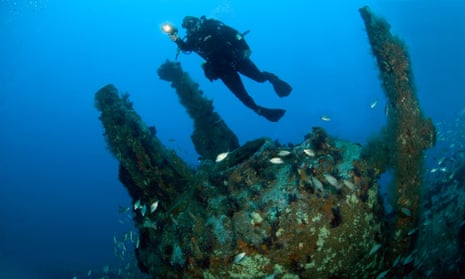In the aptly named Graveyard of the Atlantic off the North Carolina coast, researchers have found the wrecks of a Nazi U-boat and the ship it sank during a second world war convoy.
“That whole battlefield scene is there,” said Joe Hoyt of the National Oceanic and Atmospheric Administration, chief scientist for the expedition. “Both sides of the story are represented as a memorial to history.”
A research team using sonar found the wrecks of U-boat 576 and the freighter Bluefields on 30 August in waters off Cape Hatteras, just 240 yards apart. The U-boat had attacked the Bluefields, which was operating under the flag of Nicaragua and was part of a convoy of 19 merchant ships.
The US navy and coast guard were escorting the ships from Norfolk, Virginia, to Key West, Florida, when the U-boat attacked on 15 July 1942, sinking the Bluefields and damaging two other ships. A US aircraft bombed the U-boat and a merchant ship attacked with a deck gun.
All 45 men aboard the U-boat died and are believed entombed in the shipwreck; no one on the Bluefields was killed, Hoyt said.
NOAA delayed releasing information about the discovery until Tuesday to give the Germans time to track down and notify any survivors of the 45 men, Hoyt said.
The German foreign office told NOAA that it is not interested in recovering the remains but asked the US to view the wreck as a war grave. “As such, they are under special protection and should, if possible, remain at their site and location to allow the dead to rest in peace,” the foreign office said in a statement provided by NOAA.
The shipwrecks are in such deep water, about 700ft, that it is unlikely divers would be able to reach the site, Hoyt said. The wrecks are protected by international law.
The shipwrecks show how close the Battle of the Atlantic came to the United States, he said, even though many people think of it as a “North Sea-type story”.
Dixie Burrus Browning of Buxton on Hatteras Island knows better, however. Browning, 84, was not quite a teenager when the second world war was being fought close to her home.
“I remember waking up in the middle of night in our flimsy wooden house, hearing the rattle of dishes” when ships attacked each other, she said.
Wrecks of U-boats are unusual because most were scuttled as the second world war was ending, Hoyt said. Still, the wrecks of three other U-boats sit in more shallow waters off the North Carolina coast and have been used for fishing and diving, even though they are also considered war graves.
But what is most interesting about this new site is that two shipwrecks sit there, he said. “That is much more unique and more interesting than just a single vessel,” Hoyt said.
NOAA and the Bureau of Ocean Energy Management began working together in 2008 to find vessels lost off the North Carolina coast during the second world war. Researchers used archival information for an initial survey earlier this year, then used sonar on a research vessel to confirm the shipwrecks.

Comments (…)
Sign in or create your Guardian account to join the discussion